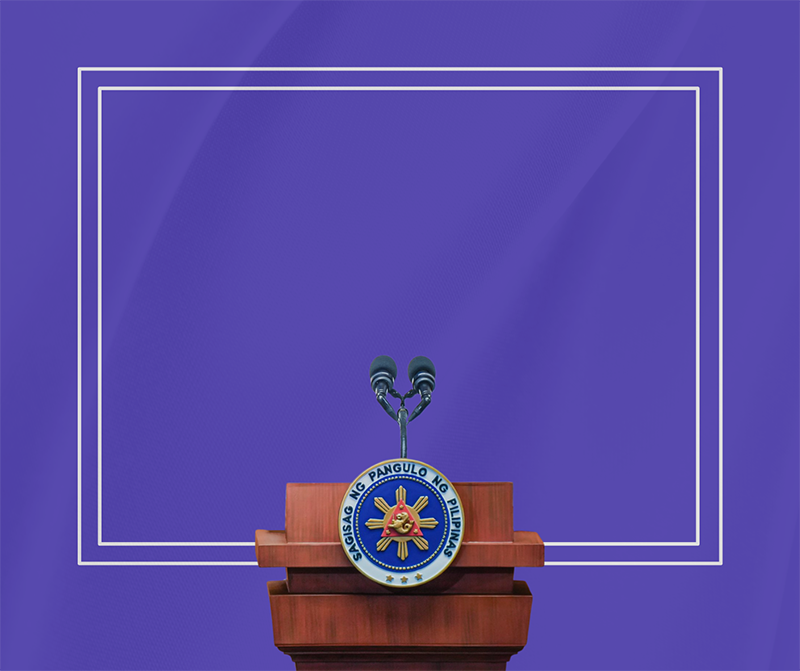How past presidents succeeded (and failed) in addressing their people.
The closing remarks of former President Diosdado Macapagal’s second State of the Nation Address (SONA) are now the stuff of legend. Something speechwriters dream about when the deadline for their principal is looming, and rightly so.
Macapagal said: “Nothing worthwhile can be achieved without tremendous effort and sacrifice. To break the manacles that hold our people chaired to misery in order that they may, at last, enjoy a prosperous life cannot be done without supreme energy and self-denial… We are so convinced in the very depths of our soul about this that we venture the appraisal that if we fail our people in this opportunity, it would have been preferable that we had not gone into their service at all.”
At the time, the ninth president of the Philippines was facing a pretty dire environment.
The government was almost bankrupt at a deficit of P250 million. The international reserves were in deep extremis. There was general popular malaise and resignation about graft; a cynicism now embedded in our culture about government services that corruption came with any interaction—inevitable as a feature, not a bug.
After that speech though, his approval ratings and public opinion shot up—accompanied by the follow-through via policy and major institutional changes—and gave us the president we remember today. These include his concerted efforts to address poverty and the landmark change in our Independence Day celebration from July 4 to June 12.
That speech cemented his enduring legacy image as the “Promised Servant of the Masses” by the time he stepped off in 1965.
The annual presidential SONA is many things. From a chance to drum up support for one’s power base to an opportunity to berate socio-political enemies, a display of fashion and clothing from officials on a real red carpet to a spectacle of drama and a temperature check of who’s changed allegiances. But above all, it is a giant political sales pitch the president makes to legislators.
Before the executive department submits its proposed budget to Congress, the speech sets the tone for the rest of the year by drawing a picture, from big outline strokes to detailed crosshatches, as an extended glimpse of what and where Congress can allocate the public funding for the government’s programs. This budget must be sent within 30 days from the SONA.
Since the SONA has no time limit, some want to speak longer than their predecessors and former president and dictator Ferdinand Marcos Sr. holds that record both in duration of delivery and in word count; two hours and 40 minutes at 29,335 words in 1969.
Despite his propensity for going off topic and improvising parts of his SONA, trailing second to the current president’s father is indicted former President Rodrigo Duterte. “Tatay Digong” comes in second, just under a minute at two hours and 39 minutes, to Marcos Sr (who also has the most number of SONAs in history at 20 speeches.)
Speaking of brevity, Sergio Osmena was only able to address the nation once, while Gloria Macapagal-Arroyo’s 2005 speech has so far been the shortest, clocking in at just under 38 minutes. Completely understandable and completely intentional, as her speechwriters would later say, after the circumstances of how she was elevated to power. Meantime, only Benigno S. Aquino III (or PNoy,) exclusively used Filipino to deliver his SONA in 2010—a linguistic milestone that has so far been unsurpassed to this day.
Ask any political speechwriter and the fundamentals of crafting a good speech remain the same.
Strike a balance between substance, sincerity, and strategy. Be clear with your messaging, the consistent theme of what you want through all the details and statistics. Include the clarity of positing what the country’s problems are and the solutions you’re proposing. Be accountable and acknowledge the challenges you’ve faced while tackling those issues, as well as report on the progress you’ve made in your campaign promises. Show the public your vision; not just what’s wrong, but the roadmap going forward—like presenting how you solved a math problem. Try not to neglect anyone or alienate sectors by being a president for all (not just your political allies.) Above all, strive for a human connection as overarching and abstract national policies get lost in data and legalese. Tie your proposed solutions to the common tao, to personal and real-life stories.
Now, try to deliver all that with a natural authenticity and warm gravitas Filipinos expect from a leader.
A SONA can be viewed as a tightrope act or a drawn-out boxing match. Either way, you’ll need the story told the way you want while the spotlight is on you.
Ahead of President Bong Bong Marcos’ 4th SONA on Monday, 28 July 2025, let’s go back through recent history and see what separates a serviceable speech from a good one; what elevates the good to impressive.
Avoid the Decorative, Avoid Over Explanation
Specific plans, not mere abstract aspirations, are always the meat that can be cut up or dressed up any way you might like it.
A fine example is how Gloria Macapagal-Arroyo’s SONAs (after her brief first speech upon taking office) were almost always laden with detailed plans and metrics. Though often criticized for being too long and overly technical, her thinking and planning as an economist were full of prioritization and actionable compartmentalization like marching orders for agriculture, education, and climate resilience (goals that could be executed in any way the LGUs saw fit).
Spell out where we are, where we want to go, and how we’re moving towards that goal. Be as synced and prepped as a military operation. Speaking of which, this is usually how former president Fidel V. Ramos focused on laying down his accomplishments as the Asian Financial Crisis raged during the late 1990s.
“I will not be a lame duck President for two reasons: First, because that is not my nature, and you know that very well. And second, the times call for vigorous tigers and not enfeebled fowls,” he said in his 1997 speech.
Ramos’s vision, laid out through clearly marked road maps of economic stability, navigated the broken terrain through what he called a “collective pole-vaulting strategy.” Beyond official reports and the metaphors of tigers and fowls, statistics towards the end of his term do display marked improvement.
FVR was able to restore “the Filipinos’ sense of self-respect and pride” by marshalling all levels of government. Something he accomplished by being the military commander he was: coaxing, negotiating, and, when needed, coercing all the forces under his baton to perform.
Reality + Rhetoric
It was former President PNoy who excelled at framing his achievements around his rallying cry of “Daang Matuwid” armed with a hefty chunk of data that ranged from economic growth to infrastructure. Then, he’d tie it to real conditions of people and how these stats affected their daily life—from how inflation meant less well-paying jobs, to how effective mass transport would lead to peace and order.
By melding rhetoric with reality, Filipinos also now remember Aquino as the president who asserted our sovereign rights in the West Philippine Sea by standing up to China’s encroachment. In his second SONA, PNoy announced his plans to take China to court before the International Tribunal on the Law of the Sea.
“Wala tayong balak mang-away. Pero kailangan ding mabatid ng mundo na handa tayong ipagtanggol ang atin.” Aquino said in 2011.
We eventually won that motion through an arbitral ruling in 2016, prompting China to reject the legality of the court. It continues its harassment up to today but we have keener exposure, highlighted through international media coverage, better defense pacts, and overwhelming public sympathy.
A Humble, Unifying Tone
The traditional, ruling elite has been a favorite punching bag for many SONA speeches including those by Joseph Estrada, Marcos Sr., and of course Duterte (though he himself was from an established clan of Davao political elites).
It’s no wonder then that Cory Aquino’s speeches post-EDSA almost always focused on the theme of national healing. The circumstances of her rise to power via snap election was just the first challenge she needed to hurdle, but she also needed to appease the moneyed old riche and the vast masses going forward.
In sharp contrast, Duterte often used the SONA as a tool to air his grievances. Nobody was safe as he attacked his critics, ranging from TV stations to drug dealers, opposition politicos to the Pope. This certainly energized his power base but absolutely alienated everyone else, like the oligarchs he liked to blame for, well, basically everything wrong with the country. No surprise, since he won on a platform to allegedly end “Imperial Manila.” To prove a point, he frequently switched to Bisaya in his speeches and SONAs, taking back power by using his hometown’s language.
Like Duterte, Marcos Sr. and Estrada have openly criticized these elites for their power mongering and penchant for manipulating policies to benefit their agendas.
To remedy this and prevent further polarization, a SONA speech must transcend partisanship. At least in tone, if not in verifiable plan. A conciliatory tenor that acknowledges different views while keeping the focus on shared, mutually beneficial goals is essential.
Try to recognize opposition viewpoints or niche struggles as a way to speak to all Filipinos and not just the power base of supporters.
Accessible Language
Duterte was the clear expert and pioneer at this. His speeches, both because of their controversial nature and their unvarnished, almost truly organic messaging, resonated strongly with the masses.
They were couched in blunt, straightforward vernacular in two languages. Accessible was an understatement. His SONAs sent foreign correspondents DMing their contacts for both Tagalog and Bisaya translators.
In the 2018 SONA, when Duterte had to delay his address for over an hour to intervene in a political drama in the Senate, his speech was laden with expletives (40 during his overall term, according to stats) as he defended his brutal war on drugs.
“Your concern is human rights, mine is human lives. The lives of our youth are being wasted, and families are destroyed, and all because of the chemicals called shabu, cocaine, cannabis, and heroin. I worry about the future because I know what crimes can do to the youth of this country.”
Even then, he also appealed to Congress to pass his tax reform agenda.
“The illegal drugs war will not be sidelined. Instead, it will be as relentless and chilling, if you will, as on the day it began.”
Meantime, Joseph Estrada connected with the masses through his signature movie star delivery and action hero swagger. It may have often lacked depth but you couldn’t argue with the way it was said. His mass appeal had already enabled him to win the presidency in 1998 and he used every tool of charm to his advantage at his speeches.
Adept at delivering catchphrases, Estrada went from “huwag niyo akong subukan” to “huwag niyo kaming hamunin” as he said that “Hindi bine-baby ang rebelyon, pinipisa,” he said in 1999.
Speaking of using accessible language, it was PNoy who mandated that Filipino be the language of choice in local communiques, and he also spoke in the vernacular at every SONA. “Wika dapat pagbubuuin tayo, hindi tayo dapat paghihiwalayin,” PNoy said at a gathering at Pambansang Kongreso sa Wika about why he chose to deliver speeches in the prevailing vernacular.
Take a cue from all three and leave the highfalutin to gatherings of intelligentsia or policy experts. Use technical language sparingly as it can alienate as much as inform.
Soundbites for SocMed, Not Just Mass Media
Virality is a real concern in this age of fractured media consumption, where the algorithm and the will of a million or so subscribers can sway political policy and social influence.
A modern SONA must create quotable, authentic moments for all platforms that thrive on short-form content despite the obvious pitfalls of such brief content.
We’ve seen how misinformation leads to echo chambers, and taking short content as gospel can become toxic to in-depth context. The balancing act of using emotional appeals and simplified messages is real and must be taken into consideration not just by speechwriters and propagandists of any party but by the presidents themselves.
To pretend otherwise is to risk becoming just another meme or remix in the comic armory of troll farms and data mercenaries.
The Secret Sauce: Appeal to Pinoy Emotions
People remember how a speech made them feel. And as a people who make decision and vote through their feelings, the Filipinos are especially susceptible by appealing to their emotions. Especially rallying cries that tug at heartstrings or inspire them to hope and dream.
There’s FVR’s push towards national pride and discipline. The legacy of PNoy parents Cory and Ninoy. The former despot Marcos Sr. used a grand rhetoric to invoke the unity needed for his vision of a Bagong Lipunan.
There’s no doubt about it. Efforts to speak with sincerity and eschewing an overly scripted delivery resonate best with the plebeian base. This is why the Roman Ceasars always promised games. This is why candidates dance and sing on the Philippine campaign trail.
“We have dared to make new beginnings—because the old paths have proved to be dead ends. We have exchanged the poor certainty of the status quo for the dynamism of a new society,” Marcos Sr. said when he announced Martial Law and asserted that it was necessary for national stability.
“None of the good that we do is ever lost; not even the light in an empty room is wasted. From Ninoy’s burnt-out candle, and thousands like it in cells throughout the garrison state, we gathered the melted wax and made more candles. To burn – not as long in such loneliness–but much more brightly all together, as to banish the darkness, and light us to a new day,” declared Cory in 1991, appealing to the same emotive strings.
Later, when Cory’s son PNoy was in office, he would often remind the public in his speeches that he was at their disposal, not the other way around. “Kayo ang boss ko,” he would emphasize as an emotional connection.
It’s true that real stories of farmers, nurses, students, or OFWs are also great to drive home an emotional appeal. GMA’s “Bangkang Papel” video during her 2001 SONA was ultra-gimmicky (and fell flat by being corny as hell) but was still on the right page with regards to efforts of trying to endear herself to the masses. Clearly, GMA’s “Bangkang Papel” boys were stand-ins for the hopes of the Arroyo administration for the lowest Filipinos.
“I am not a miracle worker. But I will do what is right and I will do my best… God will take care of the rest,” Arroyo said at the end of her speech.
Do you remember them? In the official Malacanang Palace video narrative, the three boys (Erwin Dolera, Jomer Pabalan, and Jayson Vann Banogan) had reached out to GMA by sending her letters they folded up into origami boats. When she got them (God knows how,) she was utterly moved by their story, their dreams of lifting their families out of poverty, that she granted all three of them scholarships.
Dolera and Pabalan eventually did graduate. But Dolera died early, succumbing to pneumonia and complications due to tuberculosis at San Lazaro Hospital after two weeks of confinement. He was 24 years old. He was eight when he appeared in GMA’s SONA.



